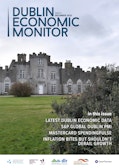The latest Dublin Economic Monitor (DEM), published this morning by the four Dublin Local Authorities, shows that the Capital’s main economic indicators are pointing towards a slowdown in activity.
Inflation and the global economic downturn remain pervasive issues and are reflected in the Q3 Dublin S&P Global Purchasing Managers’ Index (PMI) which recoded 50.4 in the quarter. This is barely above the 50 mark which signifies an expansion. The services sector was the sole driver of the growth with an index reading of 52.5. This was just enough to compensate for contractions in activity in both the construction (43.3) and manufacturing (48.1) sectors in the quarter.
According to MasterCard data, the value of retail spending by consumers in Dublin continued to grow in Q3 2022 although this was driven by price inflation. While spending rose by 1.3% QoQ and 6.5% YoY (SA) consumers are purchasing smaller volumes of products at higher prices. In a somewhat disappointing return for the Capital’s economy, tourist spending grew by just 0.4% QoQ in the late summer season. This is below expectations for a tourism sector which is still recovering post-pandemic.
While labour market trends remained strong in Q3, Dublin’s unemployment rate rose by 0.4 percentage points QoQ to stand at 4.9% (SA). The increase was partially attributable to a 12,500 (-2.3%, SA) fall in private services sector employment in the quarter. This includes the tech sector where high profile job losses have arisen.
The Capital’s housing market continued to show the effects of limited supply and soaring demand. New housing commencements and completions largely plateaued in Q3 following strong growth in the previous quarter. Average rents grew by 1.8% QoQ in Q2 to match peak levels of over €1,863 per month. House prices also grew, though at a slowing rates of 1.4% MoM and 9.6% YoY in September.
In the transport and travel sectors, passenger numbers at Dublin Airport recovered further in Q3 as the new north runway opened. Over 7.9 million passengers (SA) passed through, representing growth of 12.9% QoQ. Public transport usage in the Capital also continued to recover in Q3 which was the first full quarter in which the NTA’s fare reductions applied. Passenger journeys increased by 11.6% QoQ, mainly influenced by Dublin Bus.
“A mixed economic picture has emerged this quarter with some indicators such as the PMI showing manufacturing and construction in contraction mode while services remain in growth territory. The economy feels like it has entered ‘wait and see’ mode as business and consumer sentiment reflects the uncertain and inflationary environment that has gripped economic performance this year. While growth is expected to continue in 2023, the pace of that growth will be much slower than in previous years.”
ANDREW WEBB, CHIEF ECONOMIST AT GRANT THORNTON
The Dublin Economic Monitor is produced by Grant Thornton on behalf of the four Dublin Local Authorities to provide timely, reliable data and commentary on the economic landscape of the Dublin region. It covers 18 key indicators, consumer spending data from the MasterCard SpendingPulse™ and provides regular insights into different aspects of Dublin’s economy.


